RV Water Softener and Deionizer
Installing an Automated Water Softener and Deionizer in an RV
Article Date: August, 2017
Article and Photography by Mark Quasius
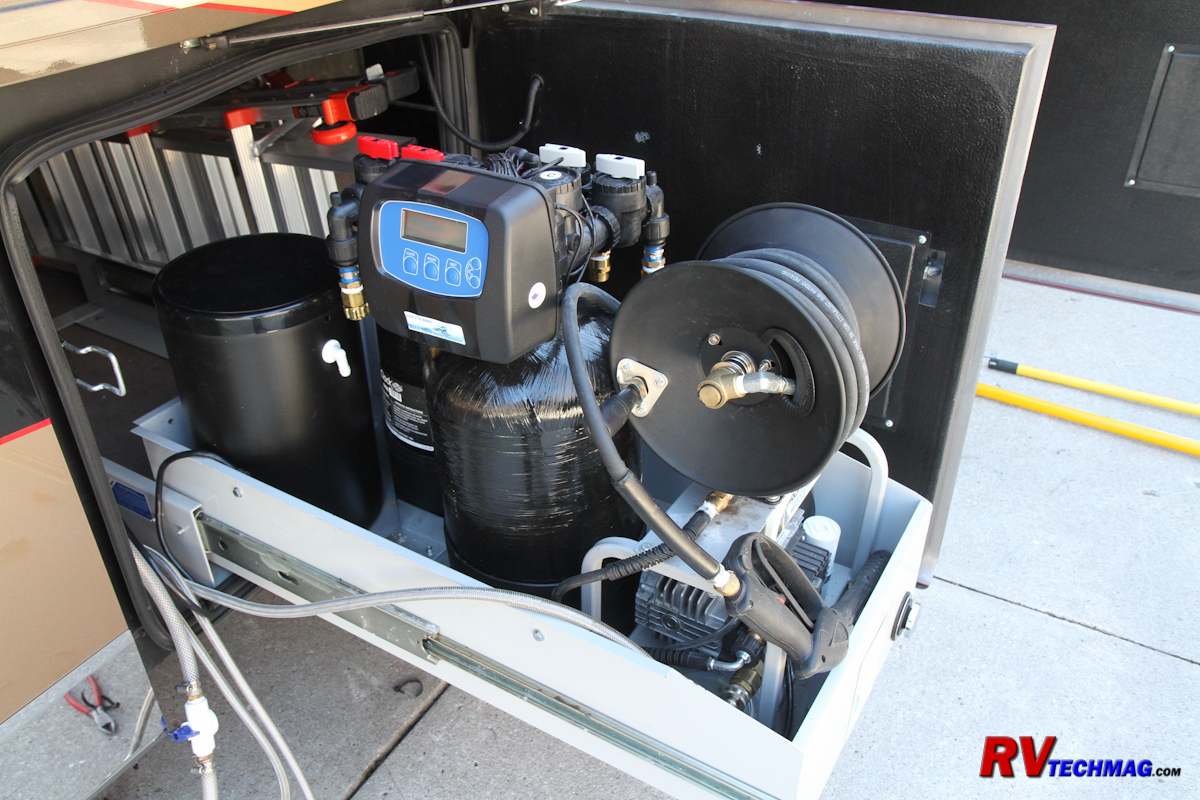
Hard water is found in many areas of the country. The hard water available at some RV parks can cause plenty of
ill effects to your RV. These can range from soap scum that doesn't rinse off to calcium deposits on dishware to damage to your plumbing
fixtures. To rectify this you need a water softener.
A second concern is how to wash a large motorcoach without leaving water spots on the finish. Even soft water
will still contain some mineral deposits and when you rinse off your coach the water will dry and evaporate but the mineral content of the water
will remain and leave water spots on your painted coach finish. To eliminate these unsightly water spots a deionizer is used.
In this article I'll detail the steps I took to install a water softener and a deionizer in my Entegra Coach. But before I
get into the details of the installation let's first talk about how water softeners work.
Water Softener Technology
Conventional water filters do not remove hardness from water. Filters function by screening out solids that are larger than
what the filter material is designed to pass. That's great for filtering silt, rust and other debris but won't stop suspended solids, such as calcium,
that is in your water. Other filters utilize carbon media but this is designed to stop bacteria and remove elements that contribute to bad taste. But
they will not remove hardness from the water.
A water softener functions on an ion exchange basis. A water softener consists of a tank filled with polymer resin beads. These
beads are treated with a salt brine solution which coats the resin with sodium ions. As the water flows through the softener the resin exchanges the
calcium and magnesium ions in the water for the sodium ions, effectively neutralizing the hardness of the water. Eventually the sodium ions
become
depleted and the softener is no longer doing its job. When that occurs it's time to regenerate the water softener.
Regeneration is when the ion exchange process is reversed. The best practice is to backwash the softener to remove any sediment
or loose material that is restricting the flow through the resin beads. After the backwash cycle is complete a salt brine is run into the softener to
recoat the media. Residential softeners utilize a brine tank where salt is held. Water is also present in the tank and the salt partially dissolves to
create a salt brine at the bottom of the tank. Automatic controllers on these systems count the water usage and perform the regeneration process as
needed, which is generally programmed to occur during the middle of the night. The first stage backwashes the media, then the controller draws the salt
brine into the softener, where it remains for a while to regenerate the beads. Finally, the softener is rinsed with fresh water and the brine tank refilled
with water so that it can make more brine for the next time.
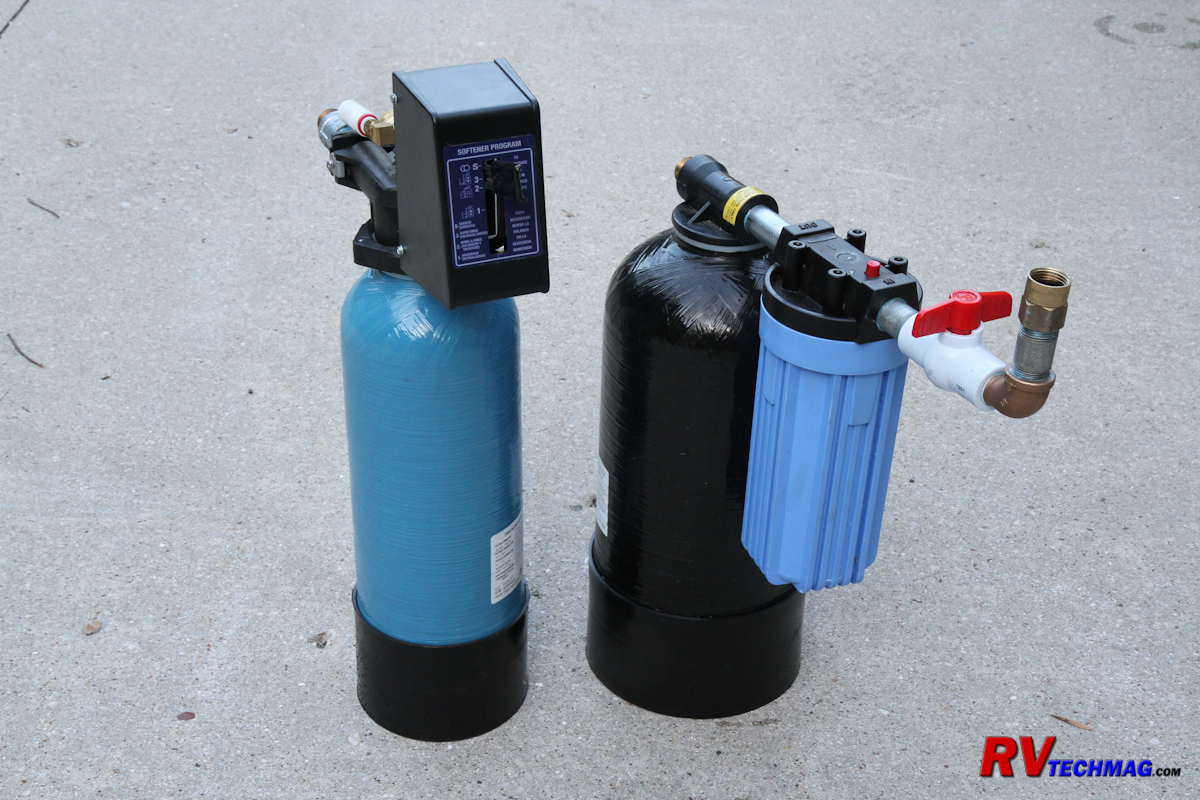
My original system consisted of a water softener with pre-filter as well as an iron filter
That's a nice automated way to manage the softener but the systems are too large for RV use so smaller portable systems are
commonly sold for use in an RV. These systems consist of a small water softener with a pre-filter. These system have no automatic controller so they
require manual regeneration. I initially had one of these and the regeneration consisted of removing the prefilter element and filling the canister with
solar salt and inserting a pick-up tube. I would then open a faucet in the coach and let a stream of water about the size of a pencil flow for about one
hour. There was no way to backwash the unit but the salt flow did regenerate the sodium ions in the beads. When finished I would remove the canister, sump
out any extra salt, remove the pick-up tube and replace the filter element. This method worked but it required a bit of effort and meant that the coach water
would be unavailable for an hour while the system regenerates.
Fortunately I ran into a great system recently released by
Motor Coach Water Filtration that packs the benefits of a residential system into a small compact system designed for motorhomes. In addition they also had
a deionizer available that would work great with my RoadWave pressure washer so I
set about finding a way to pack all of this stuff into my coach.
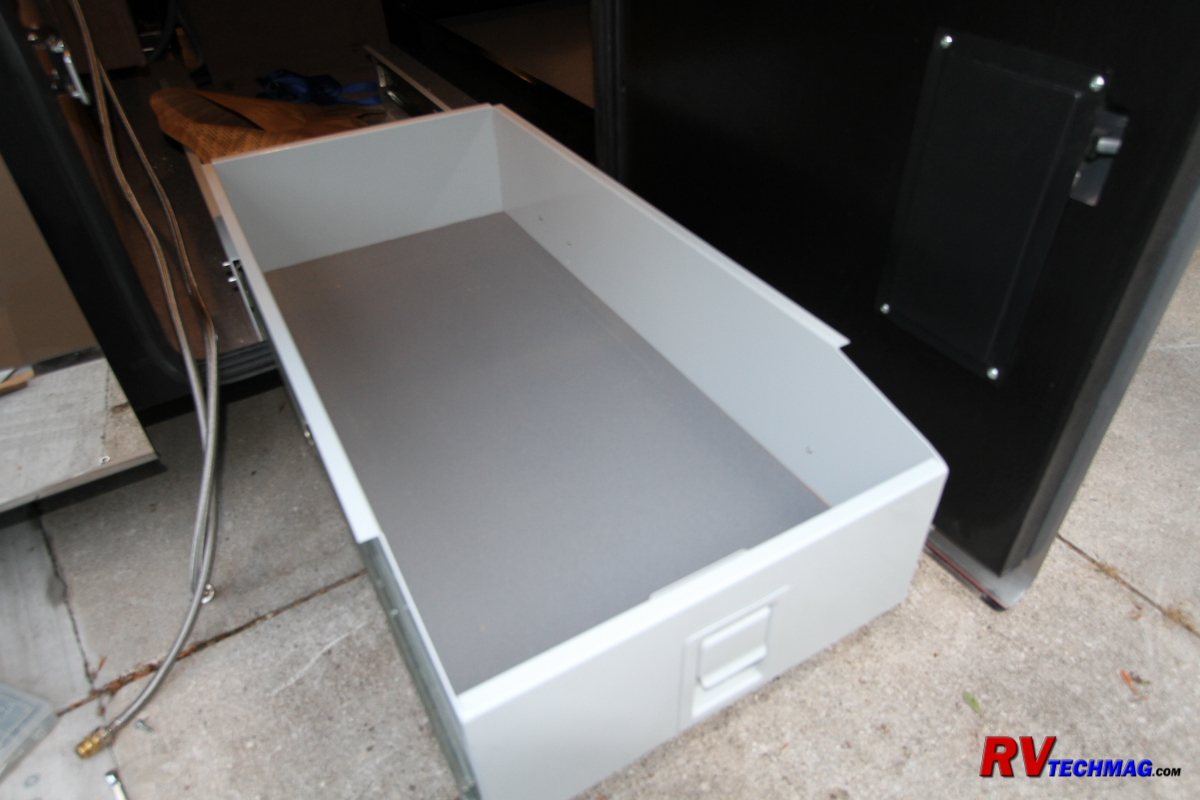
There was just enough room in the cargo tray for the softener, deionizer and pressure washer
Planning the Installation
My previous installation consisted of a cargo slide tray that was placed into a basement compartment. The water softener was located
behind my RoadWave pressure washer. I also had added an iron filter, which was located next to the softener. All of these items easily fit into that small
cargo tray, which left my other basement storage open for a pair of freezers and a Davey Crockett smoker grill. I don't travel light so I wanted to keep the
new softener in the same location, which was close to my fresh water tank and plumbing. However, I was now adding a brine tank and the cargo tray wasn't large
enough to accommodate everything so something had to go. I really like my iron filter because it filters iron and sulfur from the water and my water at home is
high in iron content and didn't want to lose it but either it or the deionizer had to go to make room for the larger 10" diameter softener tank. I decided to
relocate the iron filter because it is tall and narrow so I was able to place it in the small gap between my two main basement cargo slide trays. That gave me
just enough room to put the new softener and brine tank and the deionizer into the tray right behind the pressure washer.
Deionizers are different than softeners. Deionized water is simply water that has all of the ions removed from it. Deionizers
replace the positively charged calcium, magnesium, iron and sodium ions (cations) and negatively charged chloride, sulfate, nitrate and carbonate ions
(anions) with hydrogen (H+) and Hydroxyl (H-) ions which combine to make pure water that won't leave any water spots when dry. Deionizers do not get
regenerated but the media can be replaced when worn out. For this reason a deionizer should be reserved for spot-free rinsing of the coach and not be
wasted during the soapy wash process. I decided to feed my pressure washer with two different water supplies - a soft water wash supply and a deionized
rinse water supply. To do this I installed a pair of 12 volt solenoid valves so that I could select either source simply by flipping the appropriate
rocker switch next to the pressure washer.
|
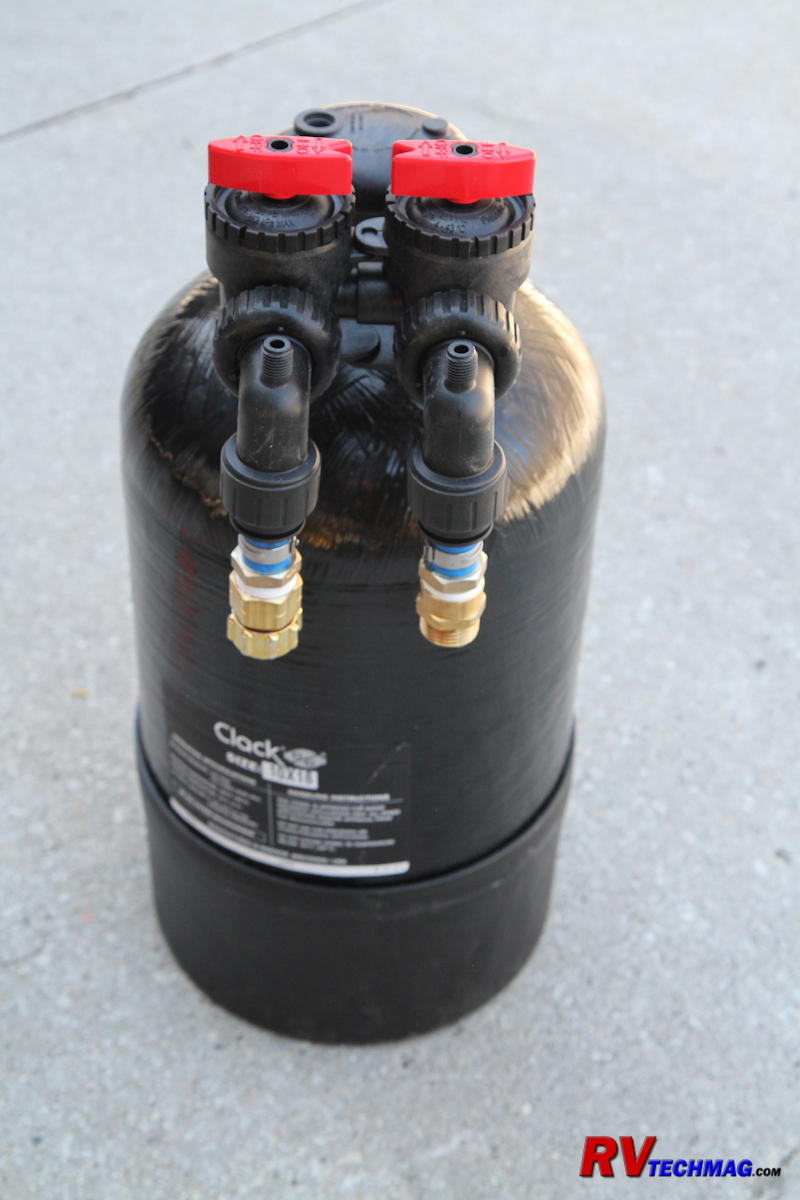
The Deionizer tank is equipped with a pair of
shutoff-bypass valves
|
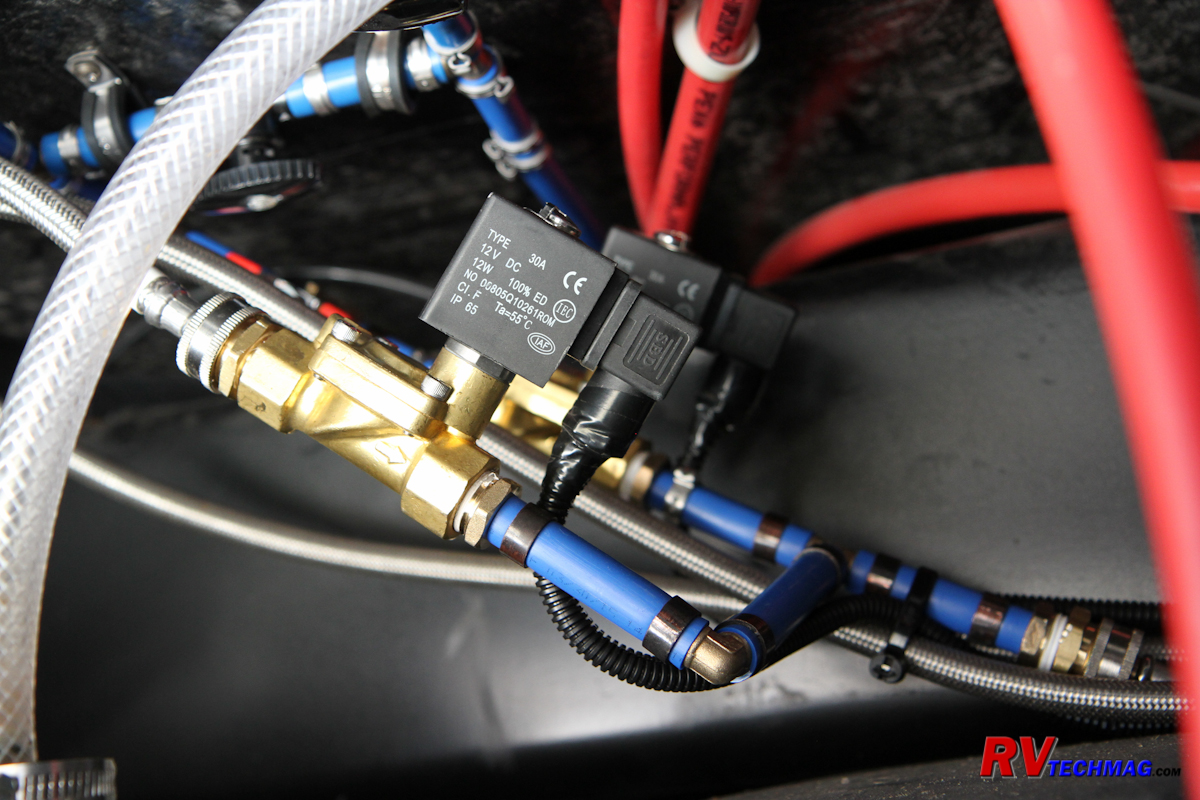
A pair of 12 volt solenoid valves controlled
water to the deionizer
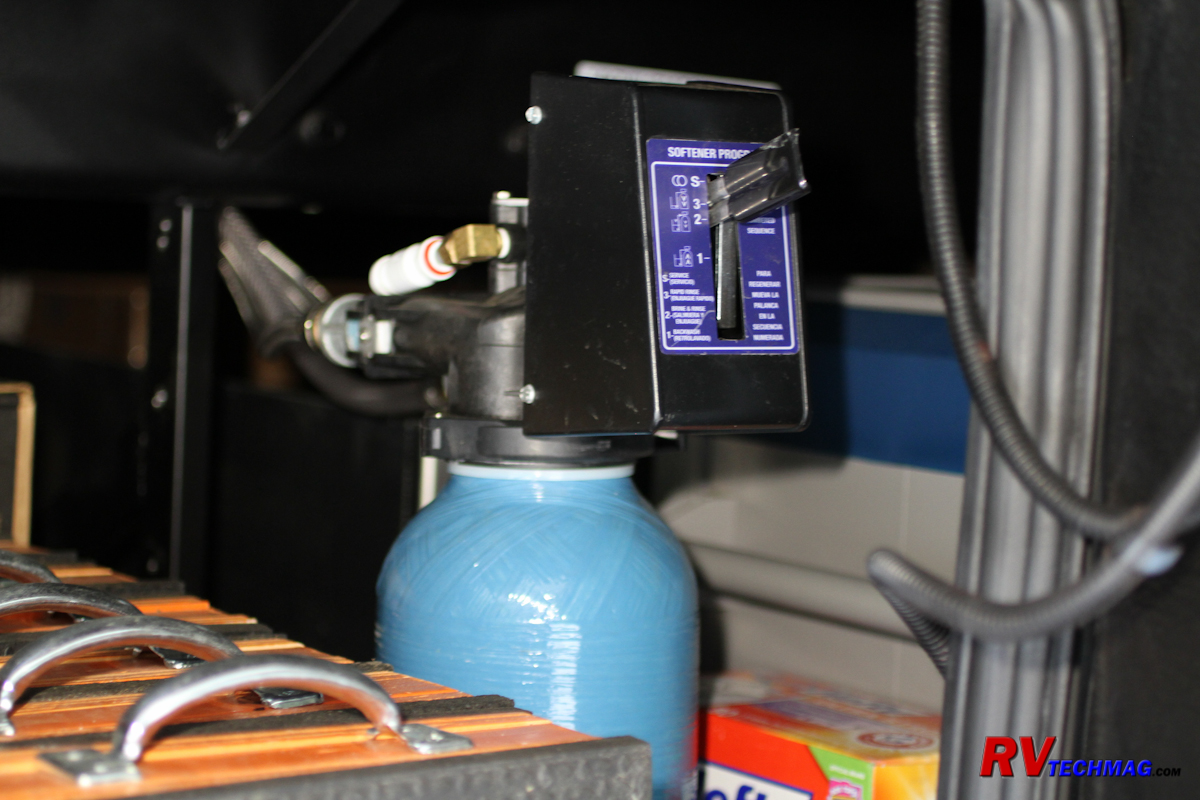
The iron filter was relocated to an available area
to make room for the softener, brine tank and deionizer
|
Installing the Equipment
I began by preparing the brine tank. The brine tank holds all of the solar salt that will be used to create the salt brine
that will be used to regenerate the water softener. Before adding salt, I removed the top cover from the brine well. There is a float valve that determines
how much water is allowed to enter the brine tank during
regeneration. As received, the float is held in place with a rubber band to prevent rattling during
shipment. This rubber band needs to be removed before use or else the tank will overflow with water.
|
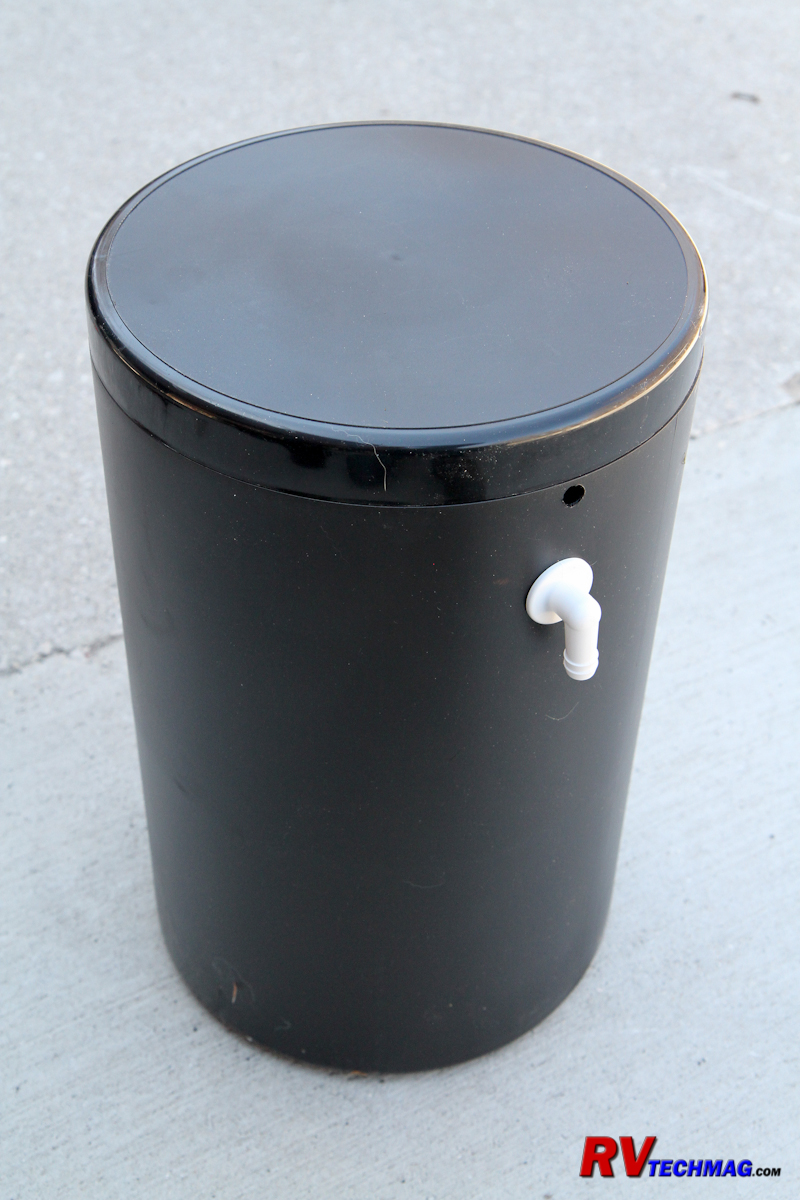
The brine tank is used to hold the salt required for regenerating the softener
|
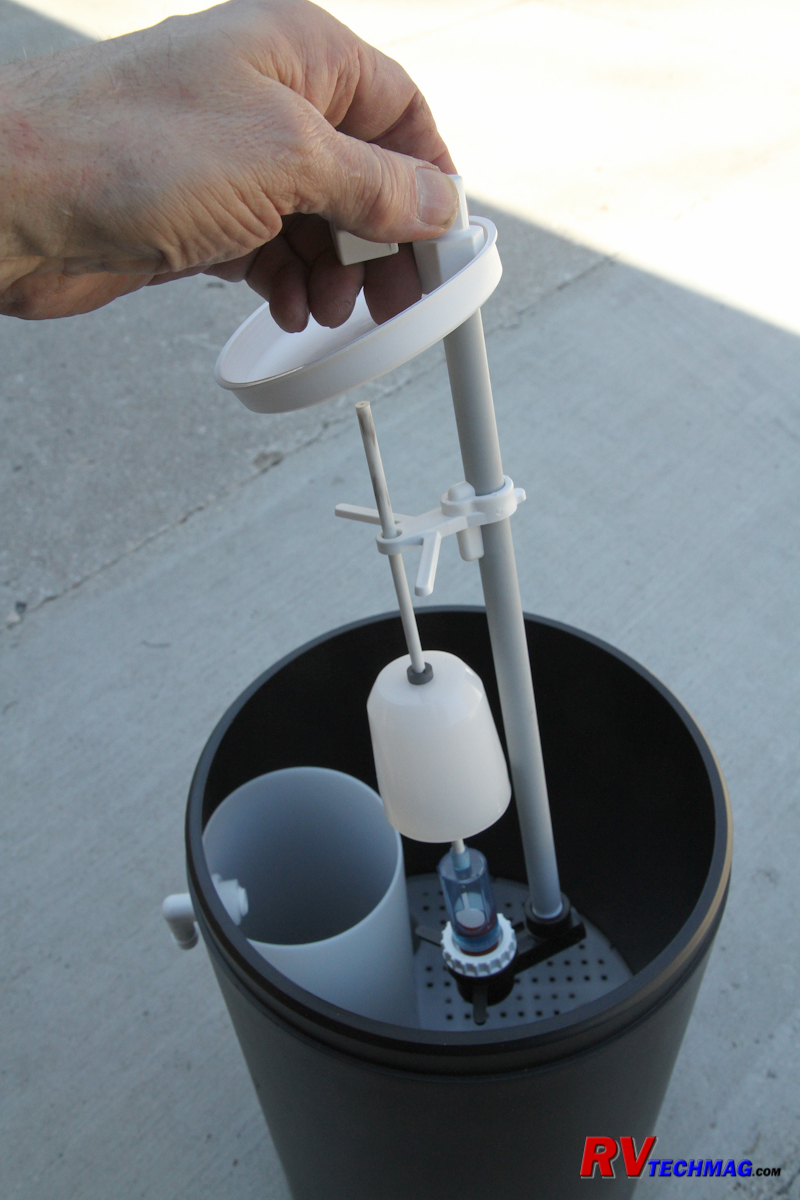
The rubber band needs to be removed from the float prior to use
|
Both the deionizer and water softener used push-in connectors design for 3/4" Pex tubing. My system was installed in a slide tray
so that I could easily access the softener for service so hard plumbed Pex wasn't going to work for me. Instead I bought some stainless steel braided hoses
with 3/4" female garden hose fittings designed for a clothes washer. These would give me the flexibility needed when sliding the tray out from the basement
compartment in the coach. I bought a few 3/4" male GHT by make GHT adaptors so that I could convert one end of each hose to male garden hose thread so that
I wouldn't get my ins and outs mixed up when I removed the unit during winter storage. I also picked up some threaded Pex adaptors so that I could adapt the
stainless braided garden hoses to the plug-in connectors on the equipment. I cut four short 3/4" Pex stubs and used a crimp tool to crimp them on to the
brass shank adaptors. I added some pipe thread by garden hose
adaptors to finish the pieces. I slipped them into the valve bodies and hand tightened the
retaining nuts.
|
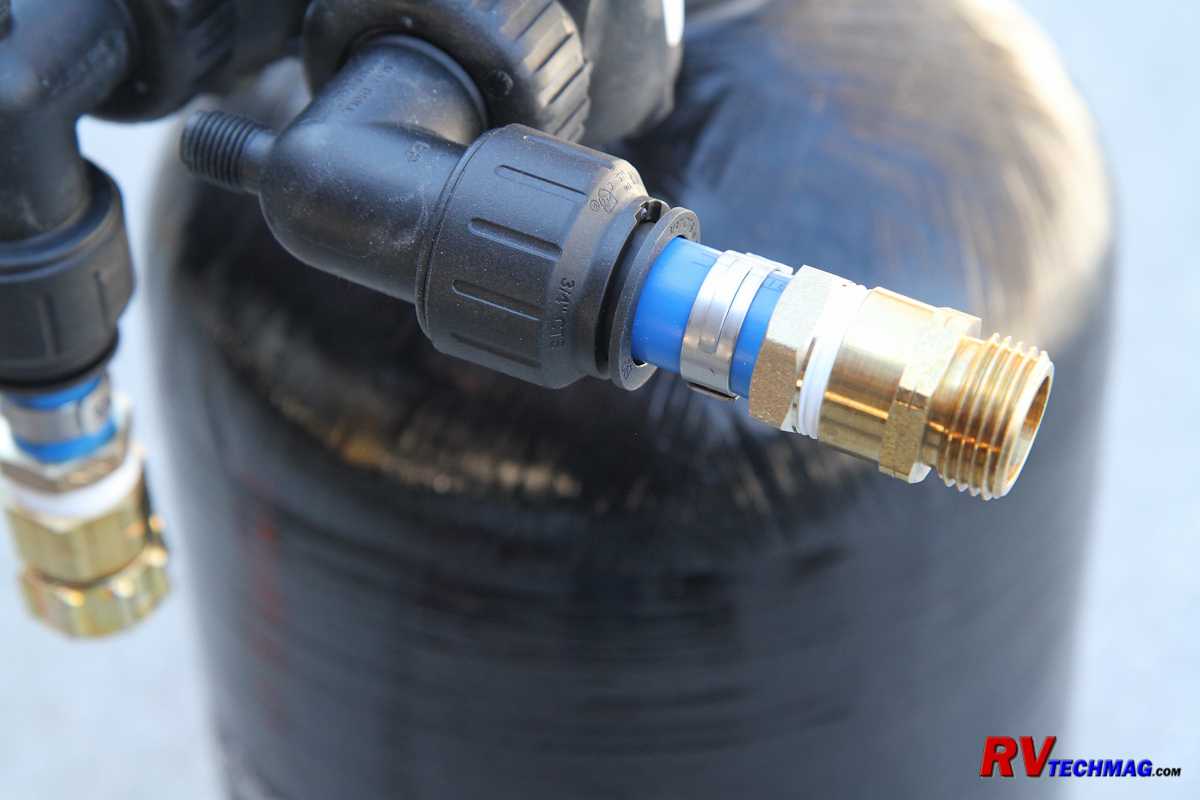
Pex to garden hose thread adaptors were made to
adapt the softener and deionizer to flexible hoses
|
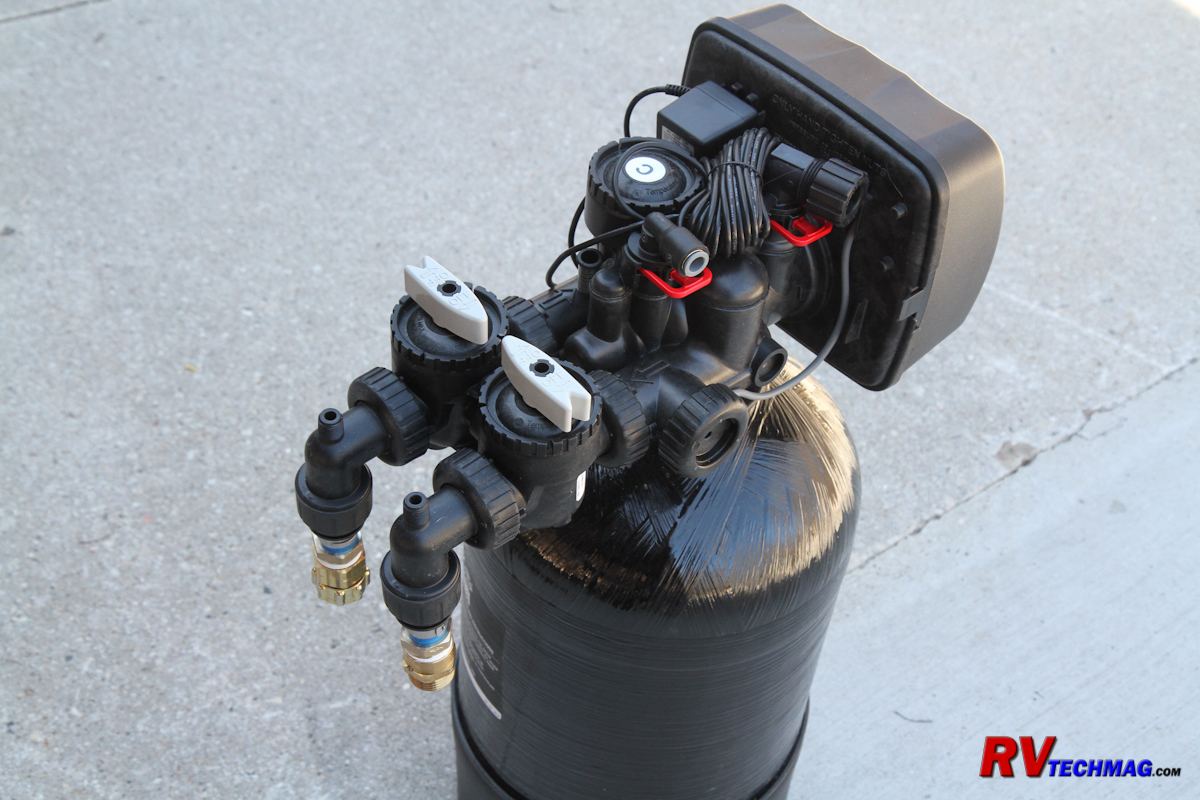
The softener - ready for installation
|
The RoadWave pressure washer was already mounted in the cargo slide tray. It needed to be on the outside edge so that it could be
easily accessed for use. The deionizer will rarely need to be accessed so the best choice would be to locate it in the back of the tray. The brine tank
will need occasional access to add salt and the softeners control panel needs to be visible to allow programming changes or to initiate a forced
regeneration cycle. These three items did eventually fit into the tray. I decided to cut some aluminum angle iron pieces which would be screwed to the
plywood floor in the cargo tray to keep them in place so they wouldn't move around when traveling.
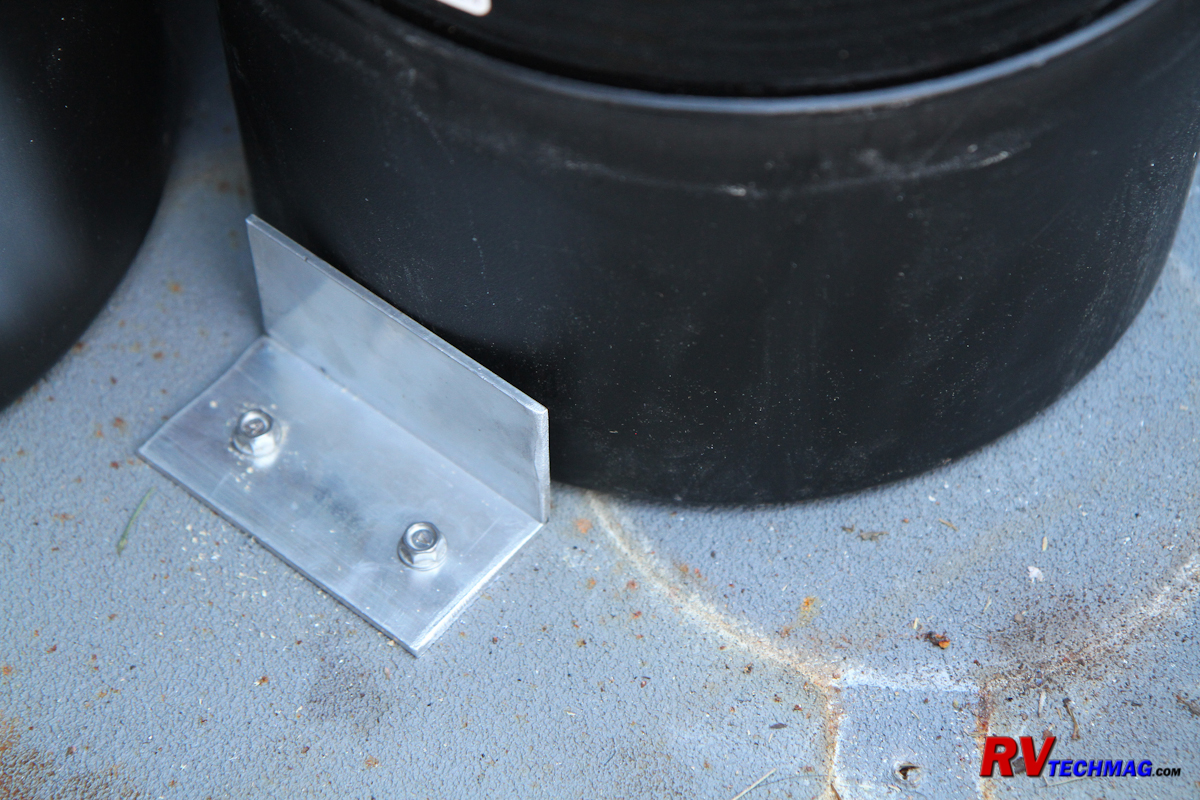
Aluminum brackets were made to keep the equipment from moving around in the tray
About 20-25 gallons of water is flushed through the softener during the backwash cycle portion of regeneration. This water is
routed to the gray water tank. I ran a polyvinyl tubing from the push-in connector on the water softener valve to the gray water tank. I drilled a hole in
the top of the ABS plastic gray water tank, threaded it with a pipe tap and inserted a brass hose barb connector to connect the other end of the hose to.
Sealant was applied to the threads. The brine tank also had an overflow hose. This is just in case the float valve in the tank failed. I simply drilled a
hole in the basement floor and ran the clear vinyl hose out through it so that any overflow would drain onto the ground. It would be clean water should that
ever happen so I didn't see the need to have to run it into a holding tank.
|
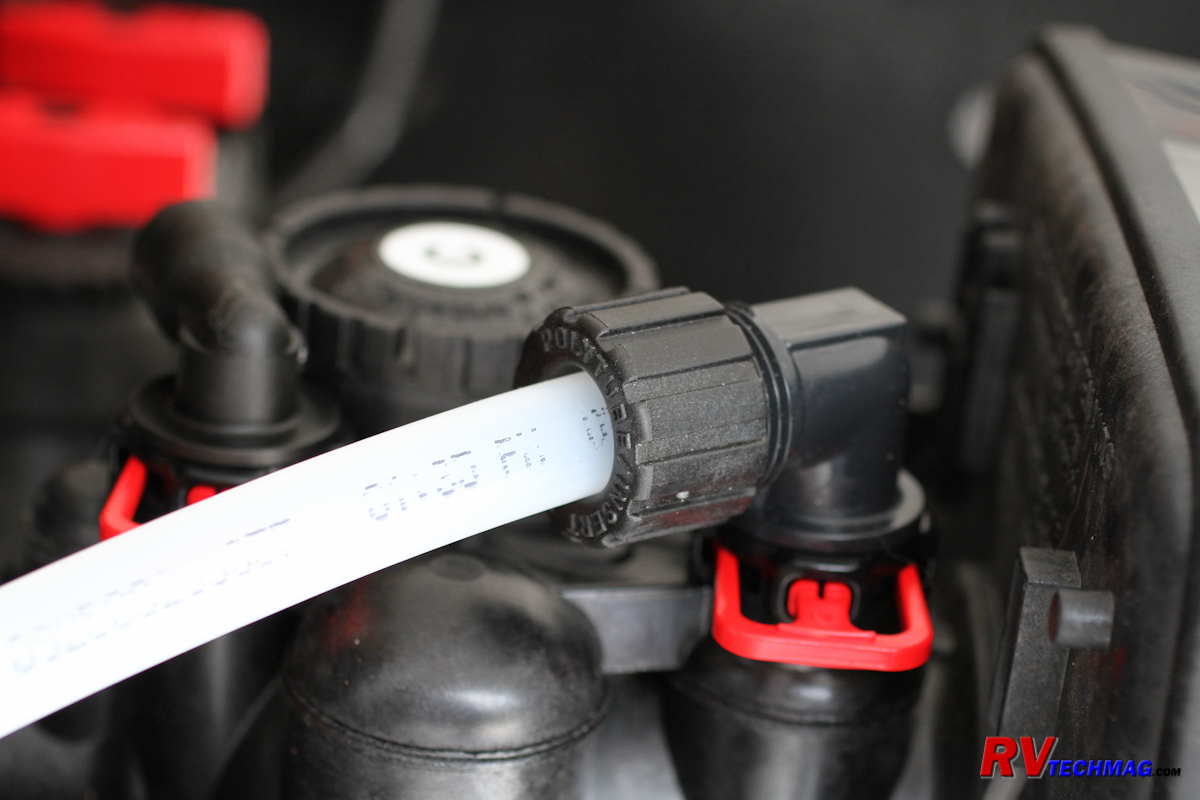
Polyvinyl tubing was run from the softener to the
gray water tank to accommodate the water flow
when backwashing the system
|
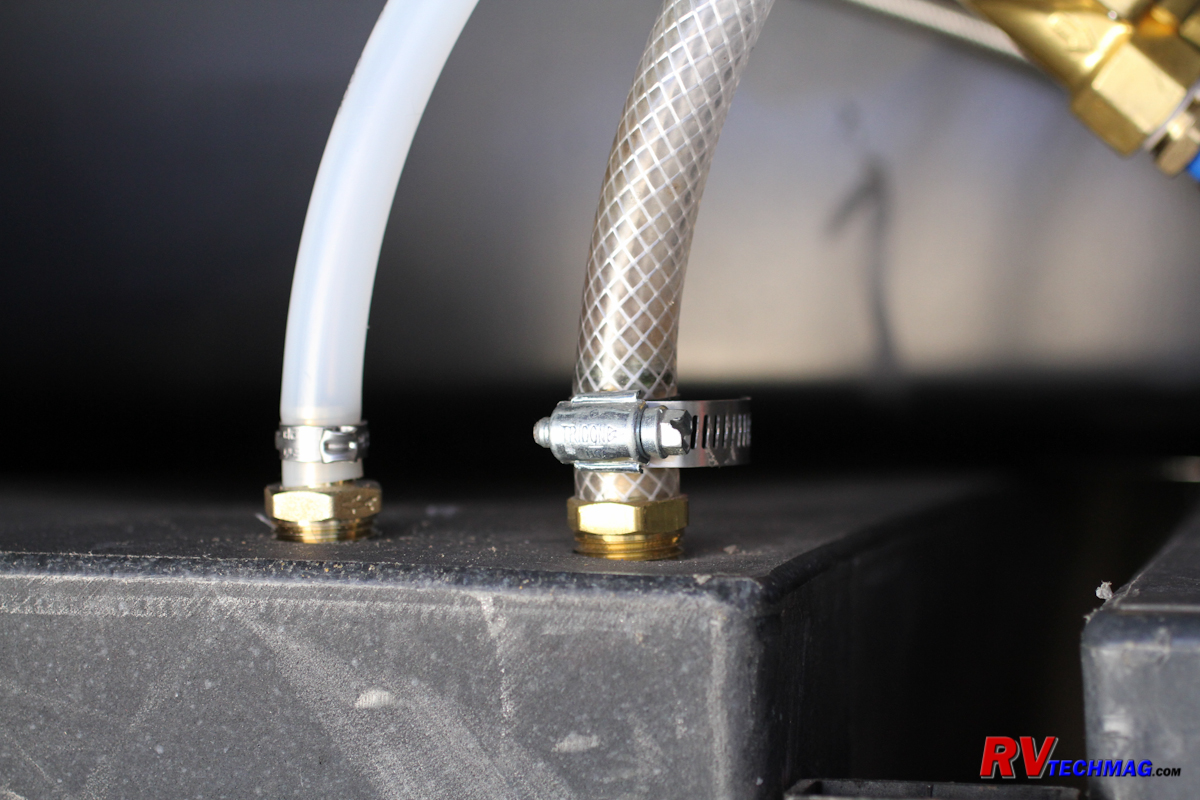
The polyvinyl drain hose for the softener was inserted
into the top of the gray tank next to the braided
clear vinyl drain line from the iron filter
|
Once everything was fastened in place, the brine tank was connected to the softener with the black nylon tubing that was supplied
with the softener. The stainless steel braided garden hose lines were connected to input and output ports on the softener and deionizer valves. A small 120 volt
power adaptor was plugged into a nearby basement electrical outlet fed by the inverter to supply power to the softener. The garden hoses, drain lines and
power cord were all bundled together with black nylon cable ties and clamped at the rear of the slide tray with rubber hold-down clamps. This allowed everything
inside the tray to remain stationary while giving enough flex between the tray and the plumbing connections in the next bay to allow the tray to easily be extended
for service access. Finally, the brine tank was filled with solar salt and 5 quarts of water were added to the tank to allow it to make the
initial brine.
|
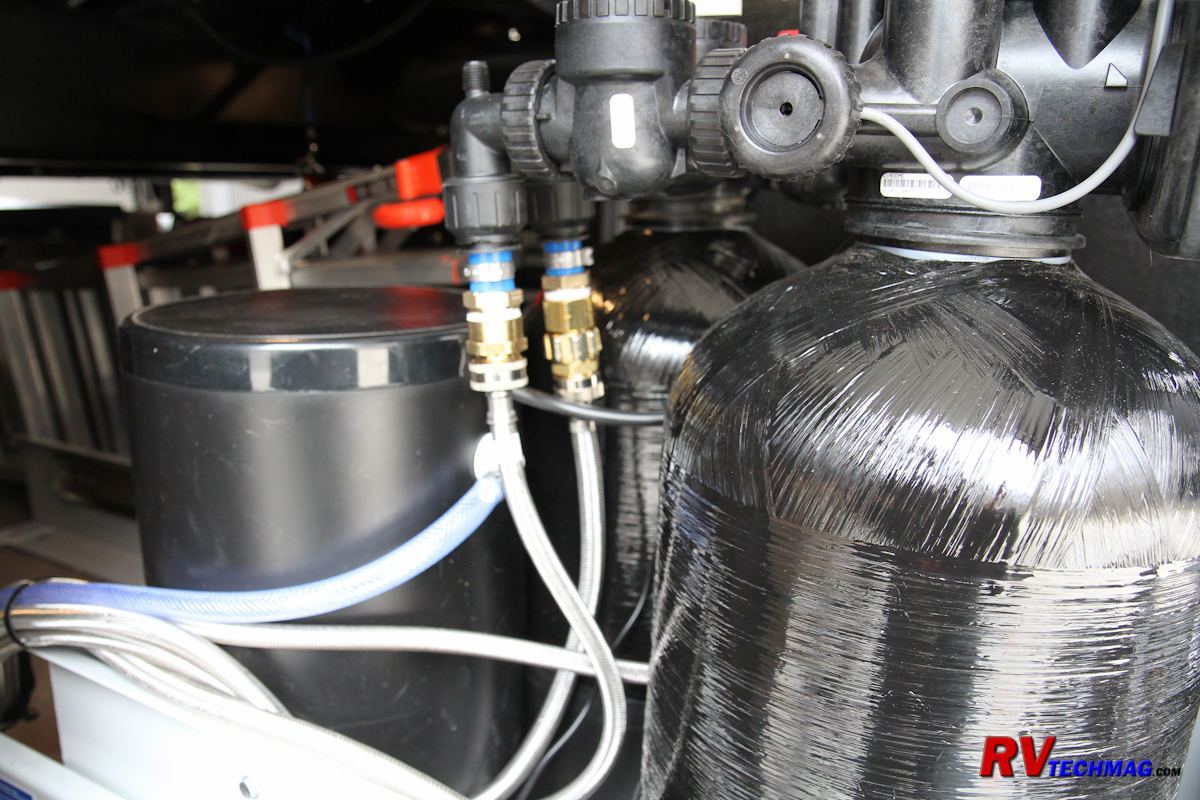
The stainless steel garden hoses were attached to
the softener and clamped at the rear of the tray
|

The overflow hose was attached to the brine tank
and the tank was filled with solar salt
|
Operating the Softener
The heart of the water softener is its controller. The controller is programmed with the
expected hardness of the water supply and the
time of day. It then counts how many gallons of water are being passed, which varies according to how hard your water is and deducts from the "gallons remaining"
counter. When the gallons remaining reaches zero, the controller will initiate a
regeneration cycle. The actual time for this to occur is pre-programmed by the
user. I chose the default 2:00 AM setting so that it would happen while we slept. When the regeneration cycle starts it begins by backwashing the softener to
clean up the resin media. It then draws in the salt brine from the brine tank and
allows the brine to soak into the resin to remove the hard water ions that
have coated the media and replenish it with sodium ions. Finally a rinse is performed and some more water is added to the brine tank so that it can make more
brine solution for the next time.
In a mobile environment such as an RV you won't have consistent water hardness from place to place as you travel. In that case it may
be necessary to regenerate more frequently if you encounter harder water than usual. Rather than reprogram the softener's controller each time you fan initiate a
manual regeneration from the control panel. Simply press and hold the Regen button to tell the controller to regenerate the softener at the usual time that night
or press twice to initiate an immediate regeneration. This is also a handy feature if your gallons remaining isn't all that low but you plan on dry camping for
a few days where a fresh water supply is not available. This allows you to conserve your fresh water supply during that time by not having to worry about an
impending regeneration that would use water.
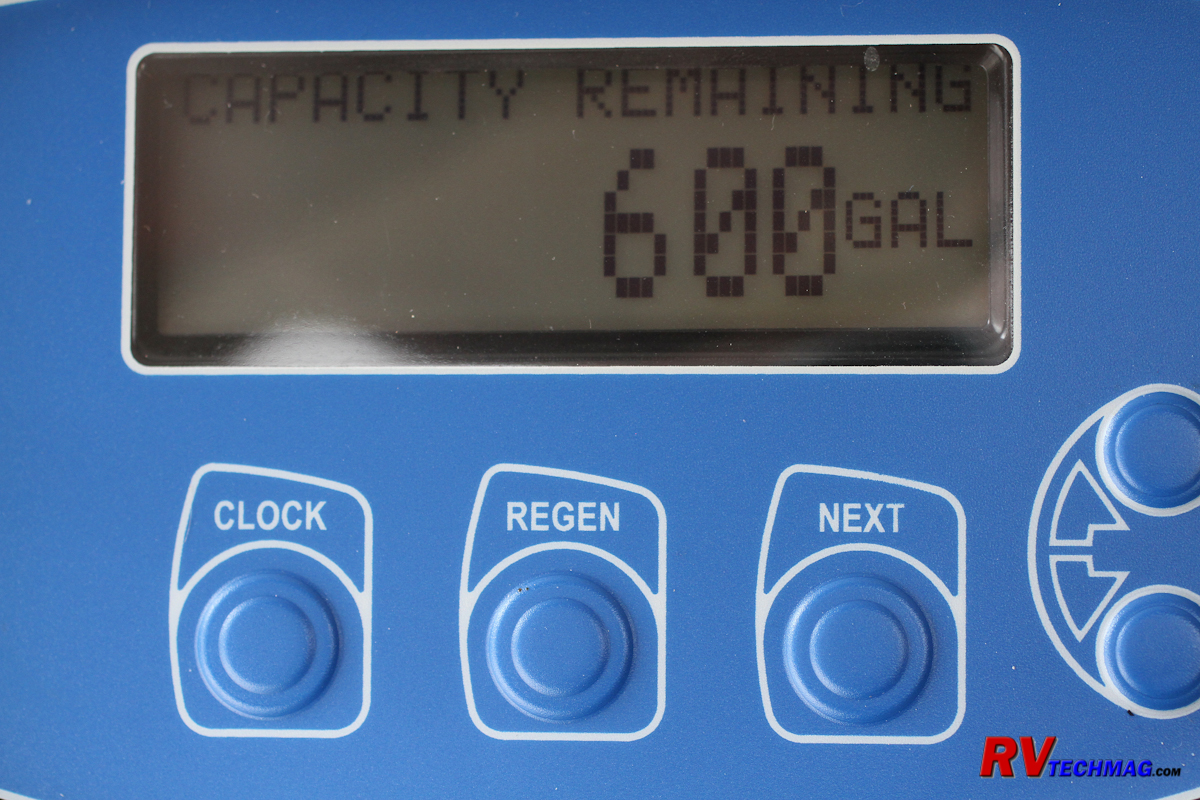
The water softener control features an easy to read LCD display
Summary
This system has proven to be a great investment. Our manually regenerating softener required a good hour of downtime while the water
could not be used during the regeneration process. The manual regeneration method also wasn't as efficient as the automatic method. It required significantly
more water to regenerate and the regeneration wasn't as thorough as this automated unit. The regeneration process is quite, although part of that is due to the
excellent insulation in an Entegra Coach, and we don't even hear it happening during the evening. The brine tank holds lots of solar salt which means you can go
a long time until you have to replenish and handle the salt. Overall, minimal effort is required to maintain the system and it's almost an "install it
and forget about it" system, except for adding salt.
The deionizer is another great improvement. The RoadWave pressure washer does a great job of washing the coach and removing bugs. But
hard water can leave water spots when it dries and trying to dry a 45' long coach that is 13' high means you can't possibly work fast enough to get them all
before it's too late. Deionized water is like those spot-free rinse sessions in the car wash. But the media is a deionizer does need to eventually be replenished
every now and then so it's not recommended to use it while washing but to save it for the final rinse. Many deionizer owners add a series of ball valves so that they
can bypass the deionizer when washing. I wanted to simplify this so I added a pair of 12 volt solenoid valves to accomplish this. I added a pair of rocker switches
to the basement wall panel by the pressure washer so I an select either softened wash water or softened and deionized rinse water with the touch of a button. I
also added a dual probe Total Dissolved Solids (TDS) meter to measure the TDS of the incoming water and the deionzer's output water so that I can tell when the
media needs to be replaced.
|
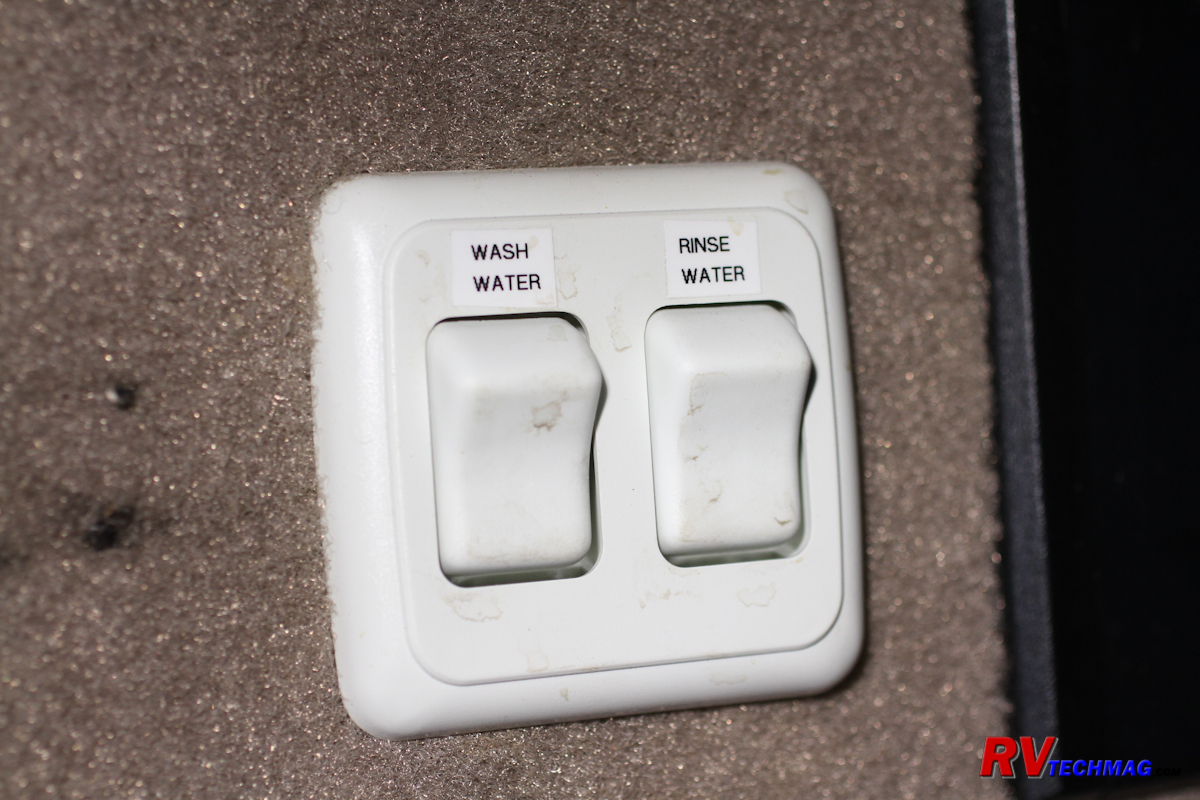
A pair of rocker switches selects the water supply to the deionizer
|
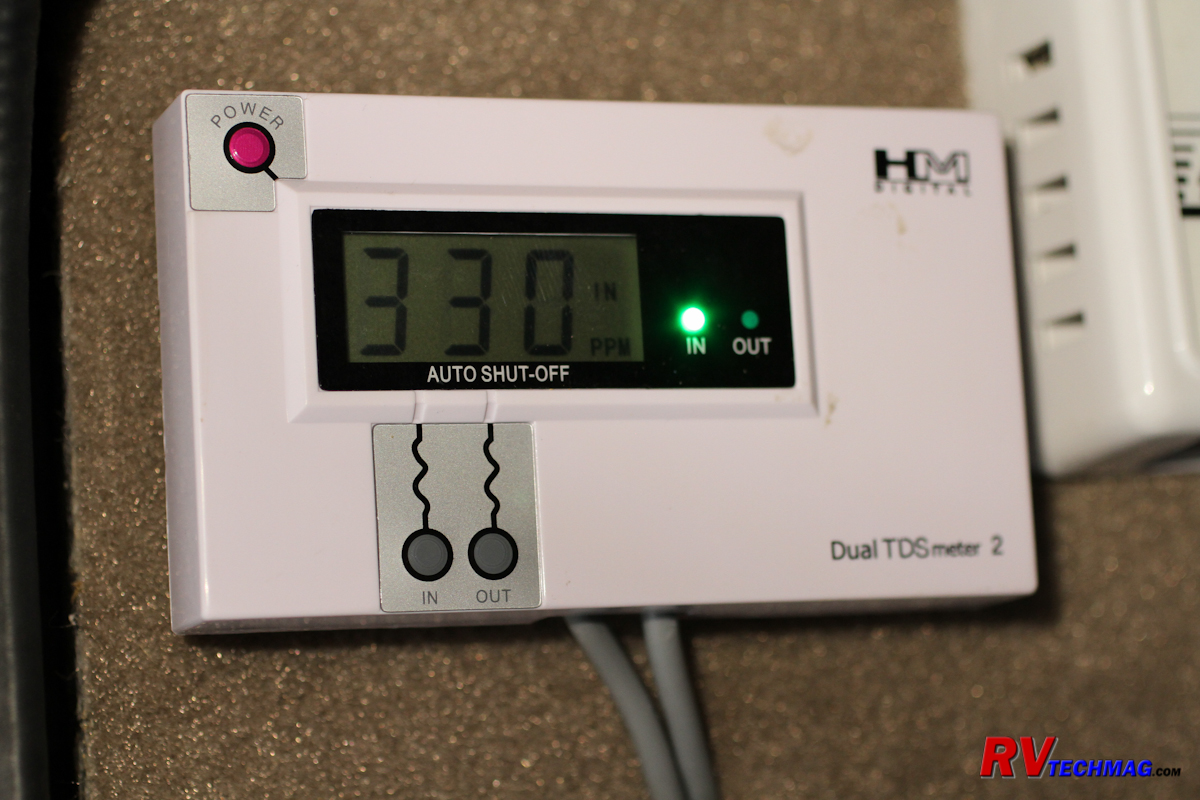
A TDS meter was added to check the condition of the deionizer media
|
Everything fits nicely into the cargo slide tray, which contains any water spills that might occur if I get sloppy and it's easy to add salt
to the brine tank or access the equipment by simply extending the tray. The pressure washer and hose reel are still at the very front of the tray so washing the
coach doesn't require pulling the tray out and the basement door can be left closed while in operation. I was able to retain my iron filter by relocating it to
an area between the main cargo slide trays and I can easily access he manual control lever to regenerate it. The iron filter dos not require salt or any
chemicals but uses air to oxidize any iron so I just need to reach the lever to operate it. All in all it's a great system.
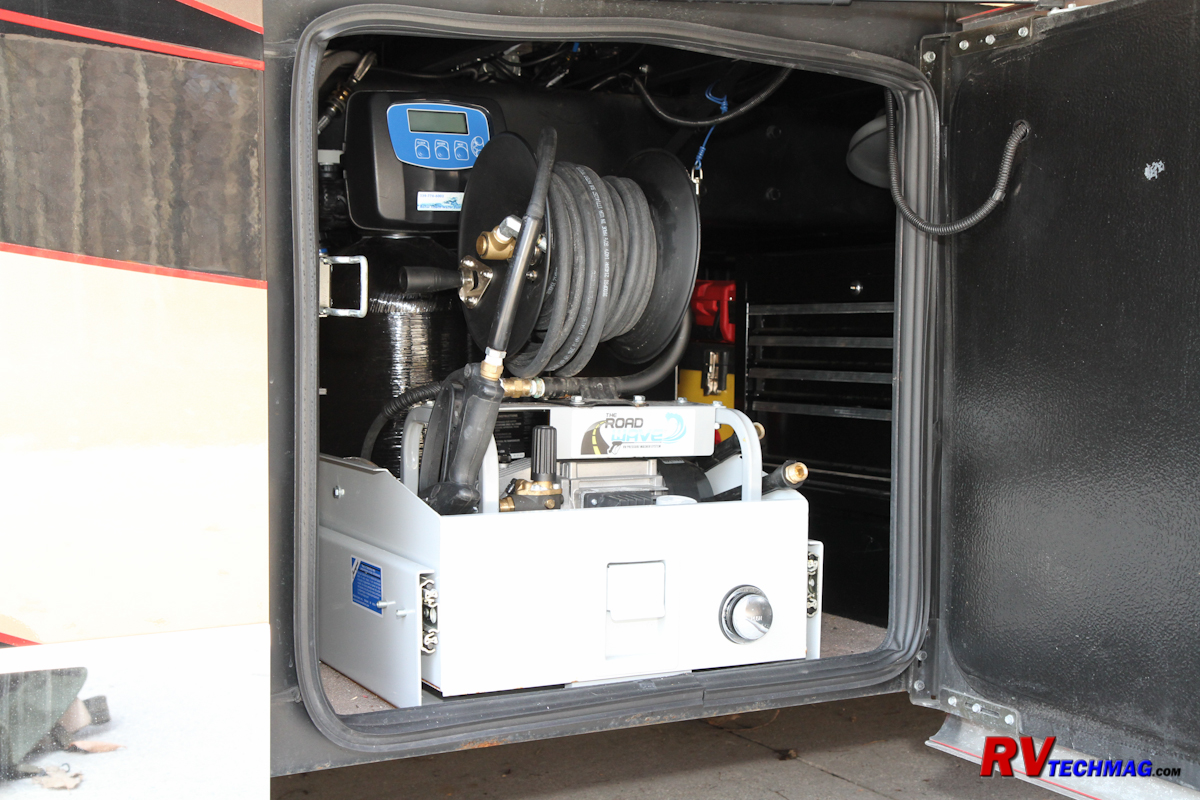
Source
Motor Coach Water Filtration
(239)776-6002
www.motorcoachwaterfiltration.com
Return to Home Page
If you enjoyed this article be sure to recommend RVtechMag.com to your friends, like us on Facebook or Twitter
or subscribe to our RSS feed.



|























